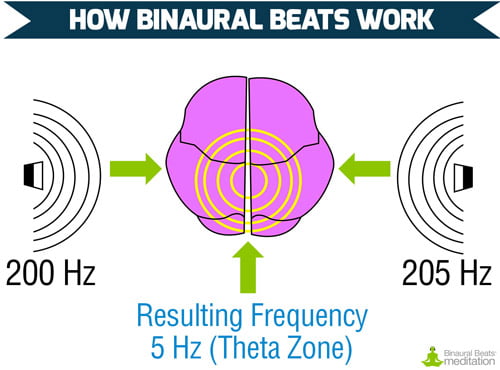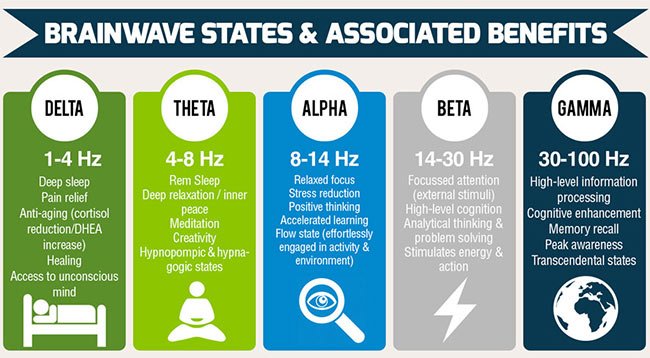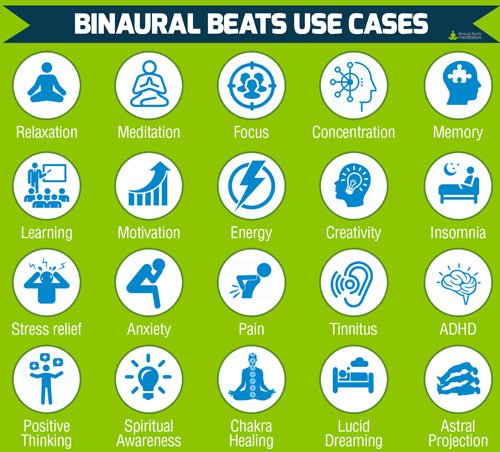Binaural beats are an auditory illusion that occur when two different frequency sounds are played in each ear through headphones. The brain perceives the difference between the frequencies as a rhythmic beat.
The effect is caused by the brain combining the two sounds and producing a third perceived frequency that is the difference between the two. The brain then follows along at the new perceived frequency and produces brainwaves of the same frequency.
This theory is known as ‘Frequency Following Response' (FFR)
While binaural beats is a fairly modern technology, sound and music therapy has been part of human societies for centuries.
In this article, we'll explore the primitive forms of brainwave entrainment and music therapy, and then look at how binaural beats were discovered, how they work, and the scientific evidence for their effectiveness.
Contents:
- Sound Therapy Through History
- Discovery of Binaural Beats
- The Science
- Brain States & Benefits
- Test Sample
- Binaural Beats Meditation

Sound Therapy Through History: Rhythm & Repetition
The creation of binaural beats music has only been possible with technological advancements in the past 100 years, but the use of this sound therapy dates back thousands of years.
Ancient cultures were aware of the brain's ability to be entrained through sound repetition, long before modern science could verify the process
History notes many examples of music used as medicine and therapy:
- The ancient Greeks used music to ease stress, promote sleep, and soothe pain.
- The Native Americans and Africans used singing and chanting as part of their healing rituals.
- Even in language we see a connection between healing and music. For example, the Chinese character for medicine includes the character for music (1).
Of course, in times past, societies didn't refer to music therapy, binaural beats, or brainwave entrainment of any kind. But what they did know was that sound had powerful healing properties.
Ancient Drumming
Interestingly, scientist Melinda Maxfield, PhD, conducted research on the drumbeats used in ancient cultural rituals and found that they generally had a steady beat of 4.5 beats per second.
This consistent rhythm induced a trance-like state in the tribe, as the brain followed along with the 4.5 beats-per-second brainwave frequency, which corresponds to a low Theta brainwave state, as you'll learn about later.
Maxfield noted:
The pattern of the drumbeat as it relates to beats per second can be correlated with resulting temporary changes in brain wave frequency (cycles per second) and/or subjective experience, provided the drumming pattern is sustained for at least 13 – 15 minutes.
This research supports the theories that suggest that the use of the drum by indigenous cultures in ritual and ceremony has specific neurophysiological effects and the ability to elicit temporary changes in brain wave activity, and thereby facilitates imagery and possible entry into an ASC (altered state of consciousness) (2).
Indeed, repetitive beat formats have played a crucial role in the well-being and prosperity of nearly every ancient culture.
Tibetan monks, Native American shamans, Hindu healers, and master yogis, for example, have utilized repetitive drumming and chanting to induce specific states of being for meditation, transcendence of consciousness, and healing.
In much the same way, binaural beats provide numerous benefits, including deeper meditation, stress relief, reduced anxiety, improved focus, better sleep, and more.
The Discovery of Binaural Beats
Heinrich Willhelm Dove
The discovery of how binaural beats work was made in 1839 by Heinrich Wilhelm Dove, a Prussian physicist and meteorologist.
Dove was an enthusiastic experimenter and his experiments paved the way for exploration in brainwave entrainment.
At the time, headphones were not available, so Dove conducted an experiment to make his discovery. He had his subject stand in a room and placed a tuning fork on one side connected to a tube leading to the subject's ear.
He then placed another tuning fork on the other side of the room connected to the other ear. The two forks vibrated at slightly different frequencies, producing different sounds in each ear.
Dove documented that the subject perceived the combination of the two frequencies as a slow beat, which is now known as the binaural beats phenomenon.
Dr. Gerald Oster
Dove made the discovery of binaural beats, but it wasn't until 1973 that biophysicist Doctor Gerald Oster brought it to mainstream attention in his paper, ‘Auditory Beats in the Brain' published in Scientific American.
Oster's paper connected the dots of previous research since Dove's discovery and gave the subject renewed relevance for modern scientific questions about sound and its impact on impairments.
Oster saw binaural beats as having both research value and as a potential diagnostic tool. He saw the potential for binaural beats to explain features of the auditory system and locate sounds spatially in our environment, as well as diagnose auditory impairments and identify a range of medical issues, such as Parkinson's Disease and hormonal cycles in women.
Central to Oster's thesis was the idea that binaural beats involve different neural pathways than conventional hearing and evoke specific neural responses. This sparked renewed interest in how binaural beats might help with modern day issues such as anxiety, insomnia, pain, and memory problems.
Today, after years of research by scientists and music researchers, binaural beats (brainwave entrainment) music is used globally to assist with stress and anxiety relief, concentration and memory issues, sleep improvement, and pain relief (4, 5, 6, 7,).
How Do Binaural Beats Work?

The word binaural means “having or relating to two ears”. This represents the process, which works by simultaneously sending a different sound frequency to each ear through headphones.
The entrainment happens inside the brain and is caused by a physiological response.
Upon hearing two tones of different frequencies – sent simultaneously to the left and right ears – the brain perceives a new tone, or third tone, as some refer to it, based on the mathematical difference between the two frequencies.
The brain then follows along at the new frequency and produces brainwaves at the same rate of Hertz (Hz), thus becoming “entrained” to that frequency.
Hertz (Hz) is the way we measure a cycle of sound. 1 Hertz means one vibration cycle per second
For example: If a 200 Hz sound frequency is sent to the left ear, and a 205 Hz frequency to the right ear, the brain will perceive a new frequency at 5 Hz – the difference between the two.
The brain then follows along at the new frequency (5 Hz), producing brainwaves at the same rate of Hertz (Hz). The technical term for this process is ‘Frequency Following Response'.
The brain will only respond in the intended way if it receives the sound frequencies at the same time through headphones. You can test this for yourself using the test tone further down the page.
All you have to do is put on a pair on headphones, relax and press play. It's that easy.
The 5 Brainwave States & Their Benefits
As explained above, we can listen to binaural beats to encourage the brain to produce brainwaves of a specific type (state). There are five main brainwave states, as follows:
- Delta: 1-4 Hz
- Theta: 4-8 Hz
- Alpha: 8-14 Hz
- Beta: 14-30 Hz
- Gamma: 30-100 Hz
The states ascend in terms of speed, starting at the slowest frequency waves, delta, to the fastest frequency waves, gamma.
The effect listening to binaural beats has on your brain is dependent on the frequency of the track and the brainwaves it stimulates production of.
For example: To induce deep relaxation, we can listen to Theta wave music.
And to encourage deeper sleep , we can listen to Delta wave music.
The graphic below shows the five main brainwave state categories used in binaural beats music, and their associated benefits:

The benefits listed under each brainwave state are general associations. It should not be assumed that all frequencies within a state’s range will produce all the listed benefits.
There are specific frequencies associated with specific states of mind, and indeed different results can be experienced in the high, middle, and low areas of each brainwave state.
Test a Binaural Beat for Yourself
Having read the information thus far, you now hopefully understand the theory.
You can test this theory in real-time by using our test tone below.
It is a raw (no music overlay) Theta binaural beat at 6 Hz.
Follow the instructions below to complete the test.
- Theta 6Hz Test Tone
- https://www.binauralbeatsmeditation.com/wp-content/uploads/2018/01/6hz-test-tone.mp3
- https://www.binauralbeatsmeditation.com/wp-content/uploads/2018/01/6hz-test-tone.ogg
- Put your headphones on and press play on the player.
- When you have both earphones in, note that you hear a single pulsating sound. Some liken it to a wavering or trembling type sound.
- Now remove one earphone; left or right, it doesn't matter. When you remove one earphone, you will notice that the pulsation disappears completely and that you hear a single tone in the earphone you still have in.
- When you put the other headphone back in your ear, the pulsating sound is present again. This is because when you have both earphones in, your brain is effectively linking the two frequencies (tones). The brain then perceives the mathematical difference between the left and right tones (creating a binaural beat). In this case, it perceives a frequency of 6 Hertz.
Please Note:
When you remove one earphone, move it as far away from your ear as possible. Depending on the headphones you're using, you may still be able to hear the pulsating sound if the removed earphone is close to your ear. This is because your brain can still detect the frequency vibration coming from the headphone.
To enhance the effect, press the remaining earphone firmly against your ear and move the removed earphone as far away as you can. Your brain will then follow along and produce brainwaves at a frequency of 6 Hz, as described in the “frequency following response” process.
You should listen to a binaural beat for at least 10-15 minutes to experience the full benefits of the entrainment.
Human Hearing Threshold & Binaural Beats
Because the human hearing threshold is usually cited as being between 20-20,000 Hz, you may wonder how it is possible to experience binaural beats frequencies below 20 Hz.
This frequency range refers to the audible pitch in music that we can hear.
It is important to note that you aren't actually hearing the frequency that the brain perceives. What you hear are the initial frequencies that are sent to your left and right ears. The binaural beat(s) is the resulting frequency that the brain perceives after hearing the sound vibrations of the two initial frequencies.
This response takes place inside the brain and is often referred to as an auditory illusion because you don't hear the resulting frequency. The brain is then tricked into responding to this frequency.
Using our earlier example, when the brain receives two sound frequencies it produces brainwaves at the resulting frequency. In this case 6 Hz. This means that the brain perceives a frequency of 6 vibrations or cycles per second and subsequently produces brainwaves at the same frequency.

Why Binaural Beats Meditation?
“Binaural Beats Meditation” is our branded term for our advanced music therapy. We were pioneers in coining the term during our research and development process.
It's important to note that not all binaural beats music is specifically created for meditation and relaxation. However, as shown in the diagram, many of its applications are associated with inducing a relaxed and meditative state of mind.
We developed this term for 3 key reasons:
1. Binaural beats music is generally designed to entrain the brain in a similar way to that of meditation; a state often referred to as mindful awareness in the present moment.
2. Our music is accompanied by ambient, relaxing music, often featuring nature-inspired soundscapes. This is similar to the sound design used in standard meditation music.
3. Similar to meditation practice, practitioners are usually seated (sometimes in the lotus position) or lying down. This is conducive to attaining a relaxed, centered state of mind, which is ultimately conducive to brainwave entrainment.
We hope you now have a clearer understanding of how binaural beats work. You can begin your journey by selecting your desired programs from our store.

